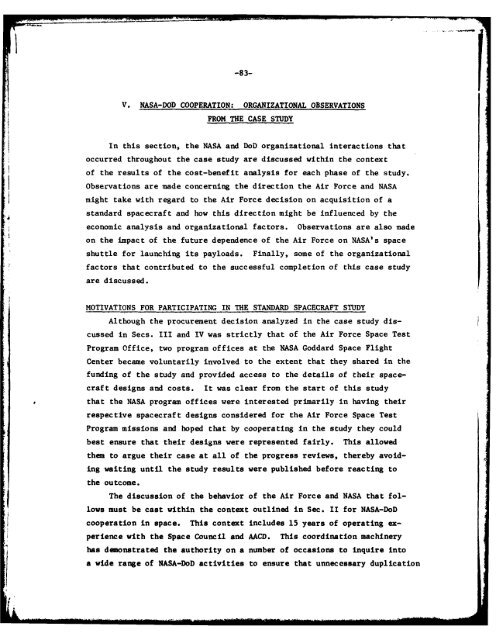A Case Study in NASA-DoD - The Black Vault
A Case Study in NASA-DoD - The Black Vault
A Case Study in NASA-DoD - The Black Vault
Create successful ePaper yourself
Turn your PDF publications into a flip-book with our unique Google optimized e-Paper software.
-83-<br />
V. <strong>NASA</strong>-DOD COOPERATION: ORGANIZATIONAL OBSERVATIONS<br />
FROM THE CASE STUDY<br />
In this section, the <strong>NASA</strong> and <strong>DoD</strong> organizational <strong>in</strong>teractions that<br />
occurred throughout the case study are discussed with<strong>in</strong> the context<br />
of the results of the cost-benefit analysis for each phase of the study.<br />
Observations are made concern<strong>in</strong>g the direction the Air Force and <strong>NASA</strong><br />
might take with regard to the Air Force decision on acquisition of a<br />
standard spacecraft and how this direction might be <strong>in</strong>fluenced by the<br />
economic analysis and organizational factors. Observations are also made<br />
on the impact of the future dependence of the Air Force on <strong>NASA</strong>'s space<br />
shuttle for launch<strong>in</strong>g its payloads.<br />
F<strong>in</strong>ally, some of the organizational<br />
factors that contributed to the successful completion of this case study<br />
are discussed.<br />
MOTIVATIONS FOR PARTICIPATING IN THE STANDARD SPACECRAFT STUDY<br />
Although the procurement decision analyzed <strong>in</strong> the case study discussed<br />
<strong>in</strong> Secs. III and IV was strictly that of the Air Force Space Test<br />
Program Office, two program offices at the <strong>NASA</strong> Goddard Space Flight<br />
Center became voluntarily <strong>in</strong>volved to the extent that they shared <strong>in</strong> the<br />
fund<strong>in</strong>g of the study and provided access to the details of their spacecraft<br />
designs and costs. It was clear from the start of this study<br />
that the <strong>NASA</strong> program offices were <strong>in</strong>terested primarily <strong>in</strong> hav<strong>in</strong>g their<br />
respective spacecraft designs considered for the Air Force Space Test<br />
Program missions and hoped that by cooperat<strong>in</strong>g <strong>in</strong> the study they could<br />
best ensure that their designs were represented fairly. This allowed<br />
them to argue their case at all of the progress reviews, thereby avoid-<br />
Ing wait<strong>in</strong>g until the study results were published before react<strong>in</strong>g to<br />
the outcome.<br />
<strong>The</strong> discussion of the behavior of the Air Force and <strong>NASA</strong> that follows<br />
must be cast with<strong>in</strong> the context outl<strong>in</strong>ed <strong>in</strong> Sec. II for <strong>NASA</strong>-<strong>DoD</strong><br />
cooperation <strong>in</strong> space. This context <strong>in</strong>cludes 15 years of operat<strong>in</strong>g experience<br />
with the Space Council and AACD. This coord<strong>in</strong>ation mach<strong>in</strong>ery<br />
has demonstrated the authority on a number of occasions to <strong>in</strong>quire <strong>in</strong>to<br />
a wide range of <strong>NASA</strong>-<strong>DoD</strong> activities to ensure that unnecessary duplication
















